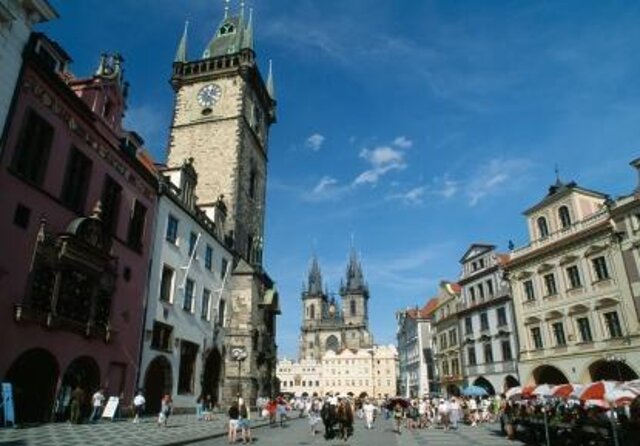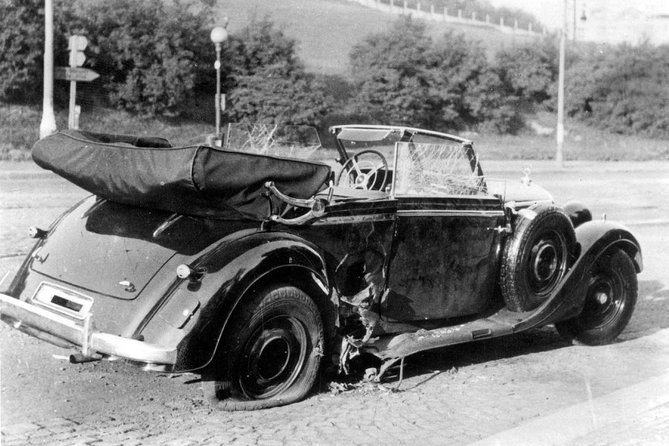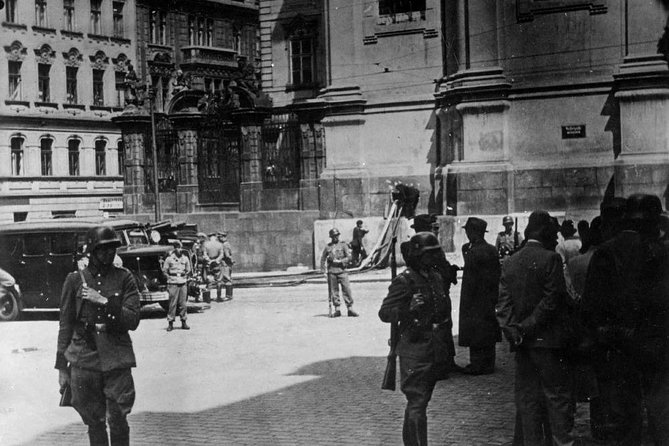Stepping into the dimly lit crypt, visitors on Prague’s World War II tour are transported to a somber chapter of the city’s past. The hallowed space, adorned with memorial plaques, bears witness to the courageous Czech resistance fighters who sacrificed their lives during the Nazi occupation. As the eerie silence envelops the group, the weight of history becomes palpable, sparking reflections on the resilience of the human spirit in the face of tyranny. This immersive experience offers a poignant journey, shedding light on a pivotal moment that forever shaped the course of Prague’s history.
Good To Know

-
The tour explores the historical significance of Prague during World War II, including the Nazi invasion, occupation, and the Prague Uprising of 1945.
-
Visitors experience the haunting atmosphere and learn about the sacrifices of Czech resistance fighters in the Crypt of the Church of Sts. Cyril and Methodius.
-
The tour includes a visit to the former Jewish primary school, serving as a poignant reminder of the persecution and oppression faced by minorities during the Nazi occupation.
-
The Memorial for Nazi Victims provides a space for reflection and understanding of the impact of the Nazi regime on the lives of Czech citizens.
-
The tour aims to leave a profound impact on participants, fostering a deep appreciation for the indomitable human spirit in the face of tyranny.
Prague’s Founding and Early History
Founded in the 9th century, Prague has a long and storied history that has shaped it into the vibrant capital city we know today.
As the seat of the Bohemian kings, Prague flourished during the Holy Roman Empire. Its iconic architecture, like the Charles Bridge and Prague Castle, are remnants of this prosperous era.
Through the centuries, Prague weathered wars and occupation, including the Hussite Wars and the Thirty Years’ War.
You can also read our reviews of more tours and experiences in Prague.
Czechoslovakia in the Interwar Period

After the First World War, Czechoslovakia emerged as a new nation in 1918, formed from the former Austro-Hungarian territories of Bohemia, Moravia, and parts of Silesia.
The young republic enjoyed a period of relative stability and economic growth during the interwar years.
However, the rise of fascism and aggression by Nazi Germany soon threatened Czechoslovakia’s independence.
In 1938, the Munich Agreement forced the country to cede the Sudetenland region to Germany, a precursor to the Nazi occupation and hotel of the Protectorate of Bohemia and Moravia in 1939.
This set the stage for Czechoslovakia’s central role in the ensuing struggle against the Nazi regime during World War II.
The Nazi Occupation of Czechoslovakia

The Nazi invasion of Czechoslovakia in 1939 marked a dark chapter in the young nation’s history.
Hitler’s forces swiftly occupied the country, crushing its independence and democratic institutions. The Nazis imposed a brutal regime, persecuting minorities, suppressing dissent, and exploiting the Czech people.
This period saw the deportation of Jews to concentration camps, the destruction of Prague’s historic Jewish Quarter, and the rise of a courageous Czech resistance movement.
Though the country suffered greatly under the occupation, its people never lost their spirit of defiance, as exemplified by the Prague Uprising in 1945.
This turbulent history is the focus of the World War II tour, guiding visitors through the capital’s poignant reminders of that dark era.
The Prague Uprising of 1945
In the final days of World War II, the people of Prague rose up against their Nazi oppressors in a bid for freedom. The Prague Uprising, which lasted from May 5th to May 11th, 1945, was a brave and heroic attempt by Czech resistance fighters to liberate their city from German occupation. Despite being outmatched and outgunned, the rebels fought fiercely, taking control of key strategic locations and engaging in fierce street battles with the Nazis.
| Casualties | Rebels | Germans |
|---|---|---|
| Killed | 1,700 | 1,500 |
| Wounded | 2,000 | 3,000 |
| Captured | 650 | 8,000 |
Ultimately, the uprising was suppressed, but it stands as a testament to the indomitable spirit of the Czech people and their refusal to be subjugated by the Nazi regime.
Visiting the Jewish Primary School
Leaving the Memorial of Heydrich terror behind, the tour makes its way to a former Jewish primary school, a poignant reminder of the persecution endured by the Czech Jewish community during the Nazi occupation.
The group steps inside, taking in the somber atmosphere as the guide shares:
-
Classrooms that once echoed with the laughter and learning of young students now stand silent, a haunting testament to the darkness of that era.
-
Faded chalkboards and desks, remnants of a time when education was a right, not a privilege, now serve as a stark contrast to the oppression that followed.
-
Archival photographs adorning the walls capture the vibrant life that once filled these halls, a stark juxtaposition to the emptiness that pervades today.
-
The guide’s words paint a vivid picture, allowing participants to feel the weight of history as they walk through this solemn space.
Exploring the Memorial for Nazi Victims

From the former school, the group’s next stop is the poignant Memorial for Nazi Victims. The guide leads them to this solemn site, which commemorates those killed by the Nazi regime during the occupation of Czechoslovakia.
The memorial’s somber design and stark aesthetic evoke a sense of reverence and reflection. As the tour participants explore the space, the guide shares stories of the brave Czech resistance fighters who stood up to the Nazis, many of whom perished.
The group pauses to honor the memory of the victims, gaining a deeper understanding of the immense sacrifices made during this dark chapter of history.
Inside the Crypt of Czech Resistance
The tour then takes participants to the crypt of the Church of Sts. Cyril and Methodius, a sacred space that bore witness to the heroic actions of the Czech resistance during World War II.
Inside, visitors are struck by the somber atmosphere, accentuated by:
- The dim, flickering lights that cast eerie shadows on the stone walls.
- The rows of simple wooden benches, a somber reminder of the crypt’s former use.
- The plaques and memorials honoring the brave individuals who fought against the Nazi occupation.
- The sense of reverence and respect that pervades the space, a testament to the sacrifices made by the Czech people.
As the tour guide shares the poignant stories of the resistance fighters, the crypt becomes a powerful symbol of the indomitable human spirit in the face of tyranny.
Reflecting on the Tour Experience
As the tour came to a close, participants found themselves reflecting on the profound impact of the experience.
The eerie silence within the crypt left a lasting impression, as they grappled with the solemn reality of the Czech resistance‘s struggle.
Traversing the historic streets of Prague had provided a tangible connection to the city’s WWII past, fueling a deeper appreciation for the resilience of the Czech people.
Though sobering, the tour’s blend of personal accounts and expert insights had enriched their understanding of this complex chapter in history.
With a newfound perspective, the group departed, carrying the weight of the past and a commitment to preserving its lessons for the future.
Frequently Asked Questions
Can I Bring My Own Water/Snacks on the Tour?
Yes, you’re welcome to bring your own water and snacks along. The tour is relatively long, so having some personal provisions can help keep you refreshed and energized. Just be mindful of any rules about consuming food or drinks during the tour.
Is the Tour Wheelchair/Mobility-Friendly?
The tour includes stops at historic sites with stairs and uneven terrain, which may pose challenges for those with limited mobility. Wheelchair or mobility device users should contact the tour company in advance to discuss accessibility accommodations.
What Should I Wear for the Tour?
For the tour, comfortable walking shoes and weather-appropriate clothing are recommended. Dressing in layers may be ideal as the tour visits both indoor and outdoor locations during the 2.5-hour duration.
Are Photos/Videos Allowed During the Tour?
Photos and videos are generally allowed during the tour, but visitors are advised to be respectful and avoid disrupting the experience or the guide’s instructions. It’s best to check with the tour guide upon arrival for any specific guidelines.
Is the Tour Guide Fluent in Multiple Languages?
The tour guide is fluent in multiple languages, allowing them to provide a personalized experience for participants from various backgrounds. They can communicate effectively and cater the tour to the needs of the diverse group.
Sum Up
The World War II tour with a crypt offers a powerful and poignant glimpse into Prague’s darkest chapter. Visitors explore the somber Crypt of the Church of Sts. Cyril and Methodius, where the memory of brave resistance fighters is honored. This immersive experience fosters a deeper understanding of the resilience of the human spirit amidst tyranny, leaving a lasting impression on all who undertake this journey through history.
More Tours in Prague
More Tour Reviews in Prague
Not for you? Here's more nearby things to do in Prague we have reviewed
- From Prague: Brewhemians Brewery and Nature Tour
- Instagram tour of Brussels with a private photographer
- Spiritual Prague: An Exhibition
- Unique Guided Czech Beer Experience in Prague
- Prague: Jílové Gold Mine Tour: From Geology to Pyrotecnics
- From Prague: Hot Air Balloon Ride with Champagne and Snacks
- From Prague: Bohemian & Saxon Switzerland All-Inclusive Tour
- Prague: Jazz Show with Signature Cocktail
- Prague: Jeseniky Mountains 5-Day Guided Bike Tour
- Prague: Bus and Boat Tour
- Prague: Monasteries and Parks Segway Tour with A Local Guide
- Prague: Czech Beer Tasting and Pilsner Urquell Experience
